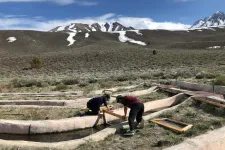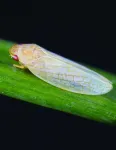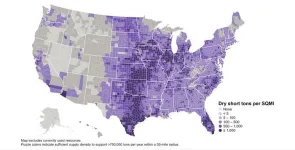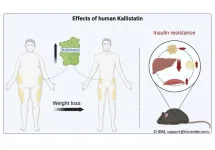(Press-News.org) Berkeley — A network of artificial streams is teaching scientists how California’s mountain waterways — and the ecosystems that depend on them — may be impacted by a warmer, drier climate.
Over the next century, climate change is projected to bring less snowfall to the Sierra Nevada. Smaller snowpacks, paired with warmer conditions, will shift the annual snowmelt earlier into the year, leaving less water to feed streams and rivers during the hot summer months. By 2100, mountain streams are predicted to reach their annual base, or “low-flow,” conditions an average of six weeks earlier in the season than now.
In a new study, University of California, Berkeley, researchers used a series of nine artificial stream channels off Convict Creek in Mammoth Lakes, California, to mimic the behavior of headwater streams under present-day conditions and future climate change scenarios.
Over the course of a summer, the researchers monitored the populations of algae, aquatic insects and other organisms growing in and around the stream channels. They found that shifting the timing of the low-flow conditions also shifted the life cycles of many of these organisms and the relative abundance of different species. It also caused pulses of midges, the dominant insect group, to nearly double in magnitude.
However, because species adjusted to the shifts in a variety of ways, the stream ecosystems were generally resilient to the changing conditions.
“We were surprised to see such a clear example of how biodiversity can stabilize ecosystems,” said study first author Kyle Leathers, a graduate student in the Ruhi Lab at UC Berkeley. “It’s similar to having a balanced financial portfolio — because different species respond in different ways to warming, the more species a river has, the more likely it is that warming will not drastically impact an ecosystem process that is key for the broader food web.”
The study appears this week in the journal Proceedings of the National Academy of Sciences.
Changing the rhythm of the seasons
Ecosystem processes follow natural seasonal rhythms, and animals, plants and other organisms are adapted to these seasonal changes. For example, aquatic insects disperse, reproduce and grow along fixed developmental timelines — and their success depends on factors such as water temperature and nutrient availability. Their predators, likewise, are cued to expect abundant populations of insects at specific times of year.
Leathers and senior study author Albert Ruhi, an associate professor of environmental science, policy and management at UC Berkeley, wanted to understand how earlier low-flow stream conditions might impact these natural rhythms.
“When you only study annual averages, you may not get the full story because important changes are happening on a much finer scale,” Ruhi said.
The system of artificial stream channels, maintained by the UC Sierra Nevada Aquatic Research Laboratory, offered an ideal location for studying these fine-scale changes. Originally built by researchers at the U.S. Fish and Wildlife Service, the channels divert fresh-flowing water from nearby Convict Creek. Each of the nine channels is 50 meters long and 1 meter wide — approximately the size of a small mountain stream — and equipped with a gate to control how much water flows through the channel.
The outdoor stream channels allow for natural colonization of insects, algae and other nutrients. They also reflect natural fluctuations in temperature, dissolved oxygen and other variables — all of which can be monitored via modern sensors.
“At this scale, this is the only system that uses natural water, not recirculated water, and the water comes from the actual snowmelt in the watershed.” Ruhi said “We could potentially run a similar study by comparing dry and wet years in natural waterways, but it's almost impossible in nature to have nine nearby, identical streams where some are under low flow and others are not.”
During the summer of 2019, the researchers set three of the nine channels to mimic low-flow conditions starting in early August, which is when streams usually reach low-flow in this region. They set an additional three channels to low-flow three weeks earlier, in early July, and set a final three to low-flow six weeks earlier, in mid-June.
As the summer progressed, Leathers and other members of the research team took periodic measurements of various stream conditions, from water temperature and dissolved oxygen levels to the number of insects in the stream channels. They found that the channels responded almost immediately to low-flow conditions with rising water temperatures, changes in algae metabolism and earlier emergence of insects.
These shifts could have significant consequences not only for the fish, but also for terrestrial predators like birds, bats and lizards that rely on pulses of aquatic insects for food. The boom in midges, for example, attracted nearby Brewer’s blackbirds, which collected the nutritious insects to feed their young.
“It is remarkable that despite the stability at the broad ecosystem level, even slight changes can be consequential,” Ruhi said. “We did not expect that early snowmelt would control the abundance of stream insects metamorphosing, leading to earlier, more abundant pulses of flying bugs that in turn attracted riparian birds. This type of cross-ecosystem linkage is something we just had not envisioned, and we would have never captured in a laboratory setting. It underlines that timing is everything”.
The Ruhi Lab is now expanding on this work to understand how climate change may lead to mismatches — or new matches — in aquatic food webs.
“Ecologists often think of climate change leading to predator-prey mismatches, because predators and their prey shift their life cycles at different rates, or even in different directions, resulting in starved predators,” Leathers said. “The notion of novel matches may be underappreciated, but important.”
Additional co-authors include David Herbst of the Sierra Nevada Aquatic Research Laboratory and Guillermo de Mendoza and Gabriella Doerschlag of UC Berkeley. This research was supported the Sequoia Parks Conservancy, the UC Valentine Eastern Sierra Reserves and the Margaret C. Walker Fund.
END
Artificial streams reveal how drought shapes California’s alpine ecosystems
Researchers used a series of channels in the Eastern Sierra Nevada to mimic the behavior of headwater streams under present day conditions and future climate change scenarios
2024-03-18
ELSE PRESS RELEASES FROM THIS DATE:
Not in my backyard? Wind turbines have little effect on US property values
2024-03-18
“The impact of wind turbines on house prices is much smaller than generally feared: In the U.S., it’s about one percent for a house that has at least one wind turbine in a 10 km radius”, explains Maximilian Auffhammer, a Professor in the Department of Agricultural and Resource Economics at the University of California, Berkeley and co-author of the study. “And what really surprised me is that the house value bounces back to the original price over the years.” The study authors also found that there was no longer any ...
The costs of a changing landscape
2024-03-18
UNDER EMBARGO UNTIL MARCH 18, 2024 AT 3:00 PM U.S. EASTERN TIME
Renewable energy sources are essential for transitioning towards a decarbonized energy system and making the electricity grid more environmentally sustainable. Clean energy alternatives like wind power can effectively replace fossil fuels, contributing to reduced air pollution and slow down climate change.
Wind power has emerged as the fastest-growing non-hydro renewable energy source worldwide. However, the implementation of wind energy infrastructure, including windmills, faces significant challenges. One major obstacle is the opposition from local communities.
Wind turbines, the primary ...
UMD researchers develop genomic method of monitoring for pesticide resistance
2024-03-18
Farmers rely on pesticides to control agricultural pests. But insects often develop resistance to the toxins in pesticides. University of Maryland researchers have developed and successfully tested a strategy for using genomics to monitor for and identify emerging resistance to specific toxins early, well before it becomes a widespread problem. The work will enable farmers to mitigate resistance and prolong the effectiveness of pest management tools.
The research was published on March 18, 2024, in the Proceedings of ...
Backyard insect inspires invisibility devices, next gen tech
2024-03-18
UNIVERSITY PARK, Pa. — Leafhoppers, a common backyard insect, secrete and coat themselves in tiny mysterious particles that could provide both the inspiration and the instructions for next-generation technology, according to a new study led by Penn State researchers. In a first, the team precisely replicated the complex geometry of these particles, called brochosomes, and elucidated a better understanding of how they absorb both visible and ultraviolet light.
This could allow the development of bioinspired optical materials with possible applications ranging from invisible cloaking devices to coatings to more efficiently harvest ...
Americans support democratic norms, elected officials don't
2024-03-18
Following the attack on the U.S. Capitol on Jan. 6, 2021, and efforts to overturn the results of the 2020 presidential election, many Americans have raised concerns about the future of democracy in the United States.
Yet the American public, including Democrats and Republicans alike, strongly oppose anti-democratic actions and partisan violence, according to a new study by the Polarization Research Lab.
"Democracy is under threat in America, but these data show we are not on the brink of a citizen-supported push toward authoritarianism," says the lab's ...
Harnessing hydrogen at life’s origin
2024-03-18
A new report uncovers how hydrogen gas, the energy of the future, provided energy in the past, at the origin of life 4 billion years ago. Hydrogen gas is clean fuel. It burns with oxygen in the air to provide energy with no CO2. Hydrogen is a key to sustainable energy for the future. Though humans are just now coming to realize the benefits of hydrogen gas (H2 in chemical shorthand), microbes have known that H2 is good fuel for as long as there has been life on Earth. Hydrogen is ancient energy. The very first cells on Earth lived from H2 produced in hydrothermal vents, using the reaction of H2 with CO2 to make the molecules of ...
Sustainable biomass production capacity could triple US bioeconomy, report finds
2024-03-18
The United States could triple its current bioeconomy by producing more than 1 billion tons per year of plant-based biomass for renewable fuels, while meeting projected demands for food, feed, fiber, conventional forest products and exports, according to the Department of Energy’s latest Billion-Ton Report led by Oak Ridge National Laboratory.
The 2023 Billion-Ton Report, or BT23, announced by DOE, is the fourth in a series of national biomass resource assessments spanning two decades. The report identifies feedstocks that could be ...
Cure Mito Foundation and Hope for PDCD Foundation announce a patient registry collaboration
2024-03-18
March 18, 2024 – Cure Mito Foundation and Hope for PDCD foundation, both patient-led foundations focused on advancing research and supporting families affected by Leigh syndrome and Pyruvate Dehydrogenase Complex Deficiency (PDCD), respectively, are excited to announce a launch of a PDCD patient registry. This innovative registry will be led by the Hope for PDCD foundation and hosted on the same registry platform as the well-established Leigh Syndrome patient registry, developed by the Cure Mito Foundation. This strategic move is aimed at enhancing patient convenience and improving data alignment and research ...
Newborn piglets serve as a model for studying influenza
2024-03-18
Although prevention and treatment strategies are available for influenza, they are not sufficient for vulnerable populations such as young children and newborns. In a new study, published in Virology, a multidisciplinary team of researchers have studied newborn piglets to better understand the progression of influenza infections.
The influenza A virus can infect a variety of birds and mammals, including humans and pigs, due to which it is a threat to public health and food security. While it causes mild ...
Kallistatin contributes to the beneficial metabolic effects of weight loss
2024-03-18
After weight loss, people with overweight and obesity express more of the protein Kallistatin* in subcutaneous white adipose tissue. This was demonstrated by researchers from the DZD in a recent study. In addition, Kallistatin improves metabolism and could open up new therapeutic options for people with obesity and type 2 diabetes in future. The results have now been published in Molecular Metabolism.
An increasing number of people are developing type 2 diabetes and obesity. These are highly complex and multifaceted diseases. In order to treat them sustainably, new approaches to therapy are needed. Clinical studies on humans have ...
LAST 30 PRESS RELEASES:
Coffee as a staining agent substitute in electron microscopy
Revealing the diversity of olfactory receptors in hagfish and its implications for early vertebrate evolution
Development of an ultrasonic sensor capable of cuffless, non-invasive blood pressure measurement
Longer treatment with medications for opioid use disorder is associated with greater probability of survival
Strategy over morality can help conservation campaigns reduce ivory demand, research shows
Rising temperatures reshape microbial carbon cycling during animal carcass decomposition in water
Achieving ultra-low-power explosive jumps via locust bio-hybrid muscle actuators
Plant-derived phenolic acids revive the power of tetracycline against drug-resistant bacteria
Cooperation: A costly affair in bacterial social behaviour?
Viruses in wastewater: Silent drivers of pollution removal and antibiotic resistance
Sub-iethal water disinfection may accelerate the spread of antibiotic resistance
Three in four new Australian moms struggle with body image
Post-stroke injection protects the brain in preclinical study
Cardiovascular risk score predicts multiple eye diseases
Health: estimated one in ten British adults used or interested in GLP-1 medications for weight loss
Exercise to treat depression yields similar results to therapy
Whooping cough vaccination for pregnant women strengthens babies’ immune system
Dramatic decline in new cases of orphanhood in Uganda driven by HIV treatment and prevention programs
Stopping weight loss drugs linked to weight regain and reversal of heart health markers
Higher intake of food preservatives linked to increased cancer risk
Mass General Brigham–developed cholera vaccine completes phase 1 trial
First experimental validation of a “150-year-old chemical common sense” direct visualization of the molecular structural changes in the ultrafast anthracene [4+4] photocycloaddition reaction
Lack of support for people on weight loss drugs leaves them vulnerable to nutritional deficiencies, say experts
Dogs’ dinners can have greater climate impact than owners’
Are you ready to swap salmon for sprats and sardines?
1.6 million UK adults used weight loss drugs in past year
American College of Cardiology comments on new dietary guidelines for Americans
American Society of Gene & Cell Therapy and Orphan Therapeutics Accelerator partner to advance and commercialize promising rare disease treatments
One in 14 patients having day case surgery have new or worse chronic pain 3 months after their operation
New study highlights link between eviction rates and gun violence
[Press-News.org] Artificial streams reveal how drought shapes California’s alpine ecosystemsResearchers used a series of channels in the Eastern Sierra Nevada to mimic the behavior of headwater streams under present day conditions and future climate change scenarios








